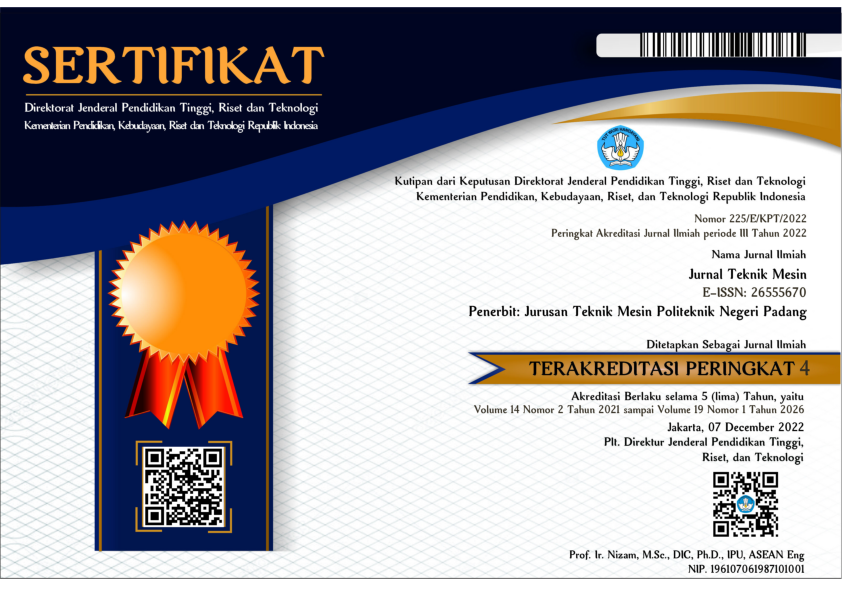Pengaruh Sputtering TiN Terhadap Kekerasan Permukaan dan Struktur Mikro Pada Material Stainless Steel 316L
Abstract
Metal-based biomaterials are highly rust-resistant. A key property that metal-based biomaterials must possess is excellent biocompatibility with living cells. AISI 316L is widely used for implantation purposes in orthopedic surgery due to its good mechanical properties and low price, but AISI 316L lacks good biocompability with the body so that implant materials with AISI 316L material cannot be used for a long period of time. This research aims to study the effect of TiN sputtering process on AISI 316L stainless steel material and titanium target material as a coating on the surface. The sputtering process was carried out on the 316L surface a variation of sputtering time of 60, 90, 120 and 150 minutes with a gas variation ratio of 20% N2 and 30% N2, using a voltage of 5 kV and the current used was 5-10 mA at a pressure of 0.079 mbar. The results of hardness testing on 316L material with TiN sputtering treatment can increase the hardness on the surface of the material. The surface hardness value of the effect 30% N2 gas ratio and sputtering duration of 90, 120 and 150 minutes respectively is 305 kgf/mm2, 310 kgf/mm2 and 334 kgf/mm2, this treatment has significant increase in hardness at 90, 120, and 150 minutes. Microstructure testing to measure the thickness of the electroplating layer results, showing that the thickness of the layer resulting from the sputtering process with a gas ratio of 30% N2 and a TiN sputtering duration of 120 minutes shows there are vacancies on the surface inserted by hard TiN atoms.
References
Wirjoadi, Siswanto, Bambang, dan Sudjatmoko. (2009). Analisis sifat mikro lapisan tipis tin pada substrat al hasil plasma, Pros. PPI - PDIPTN- Batan Yogyakarta, 17
Sridhar, T. M., Mudali, Kamachi, U., Subbaiyan, M., Corrosion Science, 45 (2003) 237-252.
U. Kamachi Mudali, T. M. Sridhar, and R. A. J. Baldev, Corrosion of bio implants, Sadhana - Acad. Proc. Eng. Sci., vol. 28, no. 34, pp. 601637, 2003, doi: 10.1007/BF02706450.
T. Sundararajan and Z. Praunseis, The effect of nitrogen-ion implantation on the corrosion resistance of titanium in comparison with oxygen- and argon-ion implantations, Mater. Tehnol., vol. 38, no. 1/2, p. str. 19-24, 2004
Yeung, K.W.K., Poon, R.W.Y., Chu, P.K., Chung, C.Y., Liu, X.Y., Lu, W.W., Chan, D., Chan, S.C.W., Luk, K.D.K., Cheung, K.M.C., 2007, Journal of Biomedical Materials Research Part A. DOI 10.1002/jbm.a, 403-414
A. Zi?bowicz and J. Marciniak, The preoperative miniplates treatment - influence on the corrosion behavior, J. Achiev. Mater. Manuf. Eng., vol. 18, no. 12, pp. 199202, 2006.
T. Sujitno, W. Andriyanti, Suprapto, V. HR, and D. Priyantoro, Pelapisan TiN Pada Biomaterial Berbasis Logam Tipe SS 316 Menggunakan Teknik D-C Sputtering, Pus. Sains dan Teknologi. Akselerator Badan Teknologi Nuklir Nasasional., vol. 75, pp. 3334
B. Arifvianto, Suyitno, M. Mahardika, P. Dewo, P. T. Iswanto, and U. A. Salim, Effect of surface mechanical attrition treatment (SMAT) on microhardness, surface roughness and wettability of AISI 316L, Mater. Chem. Phys., vol. 125, no. 3, pp. 418426, 2011, doi: 2010.10.038.
S. Soeharto, D. I. Rahmawati, dan T. Suyitno, Pengaruh Implantasi Ion Titanium Nitrida Terhadap Sifat Mekanik Biomaterialaisi 316L, J. Sains Mater. Indonesia., vol. 13, no. 4, pp. 2226, 2018.
J. S. Widiatmo and J. Hendrarsakti. Process control of milk pasteurization using Geothermal brine under Geothermal brine temperature and flow rate disturbance, IOP Conf. Ser. Earth Environ. Sci., vol. 254, no. 1, 2019, doi: 10.1088/1755-1315/254/1/01.2018.
H. N. Shah, V. Chawla, R. Jayaganthan, and D. Kaur. Microstructural characterizations and hardness evaluation of d.c. reactive magnetron sputtered CrN thin films on stainless steel substrate, Bull. Mater. Sci., vol. 33, no. 2, pp. 103110, 2010, doi: 10.1007/s12034-010-0014-z.
A. M. Ohring, Materials Science of Thin Films, 3rd ed., San Diego and p. 147. Press, 2002, M.Ohring,materials Science of Thin Films, 3rd., San Diego, AcademicPress, 2002,pp.170-172., Angew. Chemie Int. Ed. 6(11), 951952., pp. 1027, 2018.
V. Azar, B. Hashemi, R. Yazdi, and Mahboobeh, The effect of shot peening on fatigue and corrosion behavior of 316L stainless steel in Ringers solution, Surf. Coatings Technol., vol. 204, no. 2122, pp. 35463551, 2010, doi: 10.1016/j.surfcoat.2010.04.015.













